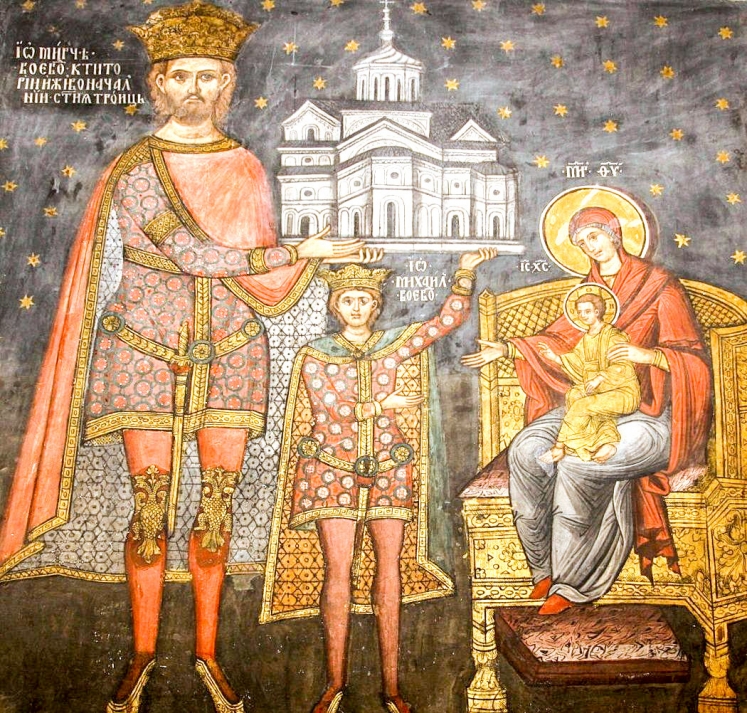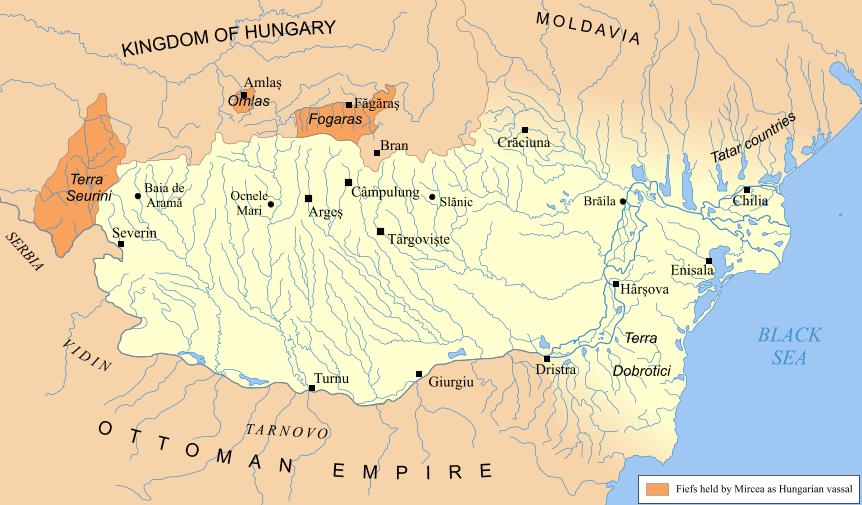“During his reign, Wallachia had the largest territorial expansion, starting from the sides of the Banat to the Black Sea and Transylvania to the Danube. He was involved in the church life of Wallachia, being alongside the metropolitans of the country, “said Father Lecturer Petre Sperlea in the dialogue held on the occasion of the 600th anniversary of the reign of Prince Mircea the Elder.
The great gentleman, Mircea the Elder, remained in our memory, the Romanians, as a precursor of the Great Union, a tireless confessor of the righteous faith. Imagine the historical figure of this great defender of nation and country.
Mircea the Great (1386-1395, 1397-1418), succeeded as the ruler of Wallachia for his brother, Dan I (1383-1385), fallen in the battles with the Bulgarian Tsar in Tarnovo, Ivan Shishman. The reign of Mircea takes place by virtue of the elective-hereditary succession system at the throne in the Basarabian dynasty. It starts in critical historical circumstances, through the Ottoman presence in the South-Eastern Europe, after 1383. For this reason, the ruler of Wallachia seeks to consolidate the Wallachian state and conclude alliances with the Christian monarchs to resist the Turkish invasions and save the Christian identity not only of its own country, but of the entire medieval Europe. These are the lines of Mircea cel Mare’s internal and external politics, which distinguish him among the Christian principles and confer the prestige of Wallachia as a center of anti-Ottoman resistance. First, he concludes an alliance treaty in Lublin in 1390 with King Vladislav Iagello of Poland to protect himself from the hegemonic tendencies of Hungary. The fall of Bulgaria in the East under the Turks in 1393 brought Mircea to King Sigismund of Luxemburg of Hungary, both engaged in the anti-Ottoman struggle by the Treaty of March 7, 1395, in Brasov. Natural relations, beyond any treaty, had with Moldovan rulers the same people and the same faith, Peter Musat, Roman I and Alexandru cel Bun, at the inauguration of the latter with a decisive contribution.From Christian solidarity he participates in the struggle at Kossovopolje (1389), but the true measure of his defending of Christianity and exceptional military strategist is given in the Battle of Rovine on May 17, 1395, when the feared sultan Baiazid I is defeated. The memorable victory from Rovine, which Mircea obtained alone, without the support of the Hungarian king, his ally, proved that the Ottoman army was not invincible and led to the military mobilization of the Christian Europe of Nicopolis a year later. At the same time, it has made the Danube to remain the natural dividing line between the Christian and the Roman-controlled Ottoman space in the South and postponed the collapse of Constantinople later, at a time when the Byzantine capital was already experiencing the twilight- agonizing of its existence.
In the battle of Nicopole (25 September 1396), with Mircea attending, the Christian coalition is defeated. The outcome of this confrontation could be avoided if, at the suggestion of Sigismund of Luxembourg rejected by Western knights, the military leadership was entrusted to the Wallachian ruler. Following this defeat, Mircea concludes a peace treaty with the Turks, forcing him to pay an annual tribute, and thus maintaining the country’s internal autonomy, a treaty that Baiazid will respect until the end of his reign (1402).
After 1403, Mircea occurs in a power struggle within the Ottoman Empire, military support Musa, one of the sons of Bayezid, but deposed by his brother, Mohammed. Attempts by other claimants to the throne of Ottoman support and her Mircea, in 1416, failed and triggered a campaign of vengeance of Muhammad in Country Romanian, resulting in loss fortified Danube Giurgiu and Turnu and Dobrogea, 1417. Since then, Mircea has to pay an annual tribute of 3,000 ducats to ensure the country’s peace and statehood.
During his reign, Country Romanian will see the largest territorial expansion, to determine which sequence from the Banat to the Black Sea and Transylvania to the Danube, as evidenced by the title Wallachian prince: “Single ruler Io Mircea, great ruler and Sir, with the mercy of God possessing total country Ungro Wallachia and parts of the mountains, even to parts Tartar and Herceg (duke) of Amlas and Fagars and ruler of the Banat of Severin and both sides over all Podunavia (by the Danube) even to the Great Sea (Black Sea) and the sole ruler of Dürstor. “
The mastery of these Romanian territories, often hunted by the great empires, and their annexation to Wallachia, shows the unifying power of the ruler and the unspoken desire, materialized over centuries by his successors, to unite all that is Romanian between the fronts of a unitary and fully consolidated state. Along with the political stability of the country, Prince Mircea also assured economic prosperity, especially through the development of trade, favored by the treaties concluded with the people of Brasov and the merchants of Liow.
Mircea the Elder was remarkable through the administrative and ecclesiastical organization of Wallachia. What are its main foundations?
Indeed, Mircea the Great was involved in the ecclesiastical life of Wallachia, being alongside the metropolitans of the country and bringing in the country after 1396 the relics of the Holy Martyr Philofteia, which are placed in the “Saint Nicholas” Church of Argeş. It cultivates a special relationship with Saint Nicodemus of Tismana, the first reorganizer of Romanian monasticism, which helps to complete the construction works of the Tismana Monastery, according to a document dated June 27, 1387. It also supports the granting of numerous taxes, and other monastic settlements across the country (Cotmeana, Snagov, Glavacioc), and the Cutlumus Monastery at Mount Athos. He is the founder of the Cozia Monastery, dedicated to the “Holy Trinity”, a triconc plan, made of stone and brick, whose construction began in 1387, being sanctified on 18 May 1388. In the nave of the church, ruler Mircea is represented in the hypostasis the founder, holding the church together with his son, Michael, associated with the reign of 1391. The two are painted in medieval knights’ costumes. The monastery shelters the tomb of the great voivode.
In 1789, the church of the Cotmeana Monastery (Argeş County) is designated as the founder of Mircea Buşteni of this settlement in 1389, although the historiography accords this quality to his father, Radu I. After the model of the Vodiţa and Tismana monasteries led by St. Nicodim, the ruler entrusts the leadership of Cozia and of Cotmeana Monastery to one person, egomaniac Sofronie.
Talk about his end and the history of the tomb at Cozia Monastery.
The ruler died on January 31, 1418, being buried not at the Princely Church of Arges, the necropolis of his predecessors, but at Cozia, his foundation. Unlike his predecessors and posters, Mircea, like his father, Radu, is buried in the Western style of the 12th-15th centuries in a stone sarcophagus. The first news about the tomb of Cozia of the ruler is given by the poet Grigore Alexandrescu, author of the creation of Mircea’s Shadow at Cozia, on the occasion of the 1842 voyage, informing: “The Lord is buried in the church at the first entrance; two large stones cover the grave. The inscription of one has begun to be wiped off so that you can hardly decipher a few words and the name of Mircea (…) “.
During the First World War, the tomb slab was damaged by the soldiers of the German occupation army, sheltered at Cozia in 1916. At the initiative of Nicolae Iorga, in 1929 the re-enactment of the sarcophagus of the prince Mircea the Great began, the work supervised by the architect I.L. Athanasescu, from the Historical Monuments Commission. The leopard is made of marble from Vraţa, with an inscription made by Friedrich Hiseck, a stonecutter from Râmnicu Vâlcea, and the Ruschuc marble sarcophagus, the reception of the work being held on 8 November 1936. On May 15, 1938, the ceremony of the rehumation of the ruler’s bones fast-organized events in the presence of many believers and personalities, such as the successor of the Royal Throne, Mihai, the professors Nicolae Iorga and Ioan Lupas, priest Nicolae M. Popescu, under-secretary of state in the Ministry of Religious Affairs and Arts, and others arriving at Cozia with a special train on the Bucharest – Jiblea route, being welcomed by Bishop Vartolomeu Stănescu of Râmnicul Noului Severin and local notables. A gesture of natural gratitude directed at a prominent leader and leader of state, which also obliges us today to celebrate the 600th anniversary of the relocation of the ruler of this life to the due homage



